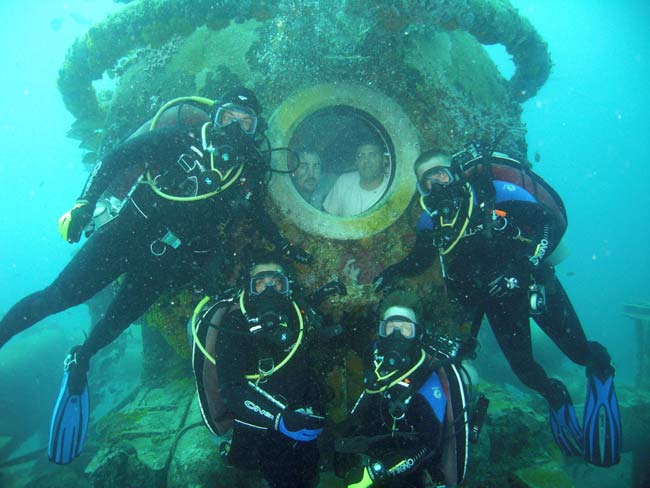Undersea NASA Expedition a Success

Sixaquanauts returned to the surface of the Earth Friday after 12 days of mockmoonwalks and robotic surgery experiments on the Atlantic Ocean floor.
The jointteam of NASA astronauts, surgeons and professional divers completed a successfulexpeditionto the Aquarius undersea laboratory, which rests more than 62 feet (18meters) below the ocean?s surface off the coast of Key Largo in the Florida Keys.
?I thinkwe?ve had a very full mission?we worked really hard, but we really enjoyed it,?U.S. astronaut Heidemarie Stefanyshyn-Piper, commander of the NASA ExtremeEnvironmental Mission Operations (NEEMO)12 team, told SPACE.com before leaving the undersea laboratory. ?Iknow I will be looking forward to some sunshine, and also it?ll be nice to havesome fresh food.?
JoiningStefanyshyn-Piper on the Aquarius mission were fellow NASA astronaut JoseHernandez, flight surgeon Josef Schmid and University of Cincinnati researcherTim Broderick, who watched over telerobotic surgery experiments with atwo-armed automaton dubbed Raven and another robot named M7. Rounding out theNEEMO 12 crew were professional divers James Talacek and Dominic Landucci ofthe University of North Carolina at Wilmington, which operates Aquarius for theNational Oceanic and Atmospheric Administration.
?Weactually had the robots doing telerobotic surgery tasks, which was a great stepforward,? Broderick said in a shore-to-sea floor phone call before coming home.
Researchersat the University of Washington's BioRobotics Lab in Seattle operated the50-pound (22-kilogram) Raven remotely vie an Internet connection. The handyrobotic surgeon and the M7 surgical automaton built by Menlo Park, California'sSRI International are being studied for future applications in remote areas ofthe world and on long-duration spaceflights.
Schmid,NASA?s first flight surgeon ever to visit the undersea Aquarius laboratory,used the experience to identify with astronautswho launch spaceward to the International Space Station (ISS).
Get the Space.com Newsletter
Breaking space news, the latest updates on rocket launches, skywatching events and more!
?To betterunderstand how to take care of our crews, we have to actually live, fly anddive with [them],? he told SPACE.com.
NASAofficials have said Aquarius, which runs about 45 feet (14 meters) long with adiameter of about nine feet (three meters), contains about the same habitablearea as the space station?s Russian-built Zvezda service module, which servesas the primary living quarters for ISS crews.
The NEEMO12 aquanauts also staged a series of undersea excursions this week usingspecially weighted and adjustable packs to mimic conditions on the Moon.
?Thisenvironment allows us to vary our buoyancy such that we can simulate theone-sixth gravity field effect that we?d be experiencing on the Moon,? saidHernandez, adding that he and his crewmates adjusted the pack?s center ofgravity to test different configurations. ?We can take this data back to thespacesuit designers so that when we go back to the Moon?we would go with a moreoptimal suit design than we had in the 1970s and the Apollo era.?
NASA plans tocomplete the ISS by 2010, retire its three-space shuttle fleet, and launch thenew Orion Crew Exploration Vehicle by 2015 for future missions to space stationand Moon.
In thenearer term, the space agency is slated to stage its next Aquarius-bound mission,NEEMO 13, beginning Aug. 13, according to the laboratory?s mission schedule.
- NEW IMAGES: Space Tourist Charles Simonyi?s ISS Trek
- Space Station Astronaut Calls Undersea Lab
- SPACE.com Video Interplayer: Space Station Ready for Orbital Expansion
Join our Space Forums to keep talking space on the latest missions, night sky and more! And if you have a news tip, correction or comment, let us know at: community@space.com.

Tariq is the Editor-in-Chief of Space.com and joined the team in 2001, first as an intern and staff writer, and later as an editor. He covers human spaceflight, exploration and space science, as well as skywatching and entertainment. He became Space.com's Managing Editor in 2009 and Editor-in-Chief in 2019. Before joining Space.com, Tariq was a staff reporter for The Los Angeles Times covering education and city beats in La Habra, Fullerton and Huntington Beach. In October 2022, Tariq received the Harry Kolcum Award for excellence in space reporting from the National Space Club Florida Committee. He is also an Eagle Scout (yes, he has the Space Exploration merit badge) and went to Space Camp four times as a kid and a fifth time as an adult. He has journalism degrees from the University of Southern California and New York University. You can find Tariq at Space.com and as the co-host to the This Week In Space podcast with space historian Rod Pyle on the TWiT network. To see his latest project, you can follow Tariq on Twitter @tariqjmalik.









